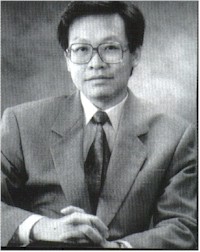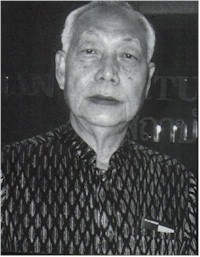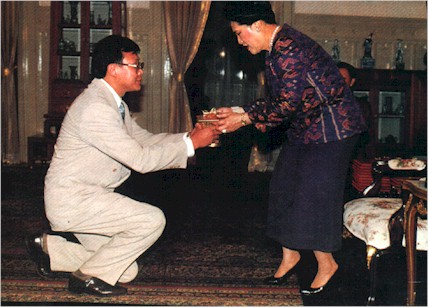From an Eighteen sq.m. Office to a 1.8 Million sq.m. Business Complex
 Henry Ho
Henry Ho
It's a long way from a small office on New Road opposite the General Post Office (GPO) in Bangkok to owning and running the fifty-nine-storey Jewelry Trade Center but that is the journey that gem entrepreneur Henry Ho and his family have made over the last three decades.
Henry was born in Rangoon, but when the military took control of that country in 1963, he, his parents and two siblings left for Thailand, leaving a younger brother and sister behind. His mother was sick at that time with a back problem, so the family had reason to seek treatment abroad. Today, Henry says, "It's amazing how political developments change lives, and how they can have such a dramatic effect on people."
The Ho's, who were originally from Canton Province in China, were a trading and merchant family that had done quite well for themselves in Burma. Henry's father, Waing Kong Ho, was a second generation Burmese, and along with his many brothers and sisters, had worked hard to build up businesses in timber, gold, gems, rice, trading, heavy machinery, cold drinks and textiles. But all that changed in 1963 when General Ne Win took charge of the country. The Burmese way to socialism brought forth many changes and about the same time, Waing Kong Ho, decided to take his wife, Margaret, to Japan for treatment on her back. As the new government replaced the old currency with a new one, Mr Ho left the country with only US$20 in his pocket.
 On arriving in Bangkok, Waing Kong Ho initially worked with the American
International Assurance Company Limited (AIA). The firm soon posted him to Hong Kong, but
he preferred Thailand because of its culture and the warmth of its people, so he moved
back to Bangkok and opened up a jewelry business in an eighteen sq.m. office across from
the General Post Office (GPO).
On arriving in Bangkok, Waing Kong Ho initially worked with the American
International Assurance Company Limited (AIA). The firm soon posted him to Hong Kong, but
he preferred Thailand because of its culture and the warmth of its people, so he moved
back to Bangkok and opened up a jewelry business in an eighteen sq.m. office across from
the General Post Office (GPO).
He soon became a pioneer in promoting the gem business in Thailand. He started a company called World Lapidary and worked as a broker claiming two percent when a deal was struck. In return, he guaranteed payment to the seller, while ensuring that the buyer received the goods in proper condition and on time. Soon he became well-known and built a good reputation for being an honest, reliable and efficient broker.
He kept this up for almost a decade, constantly working and fully dedicating himself to the business. He decided to expand his business by training young people through his knowledge in the gems and jewelry business. To incorporate this, he moved his business to the Rama Jewelry Building on Silom Road where he rented the sixth floor.
Many years later, his eldest son, Halpin Ho, set up Bijoux Holdings with a Japanese company called Kimposha. Business boomed and the company that started with fifty people went on to employ over 600 workers. The Ho's eventually expanded by renting one floor at a time at the Rama Jewelry Building and Bijoux was soon listed on the Stock Exchange of Thailand (SET).
Bijoux did well because management knew the value of cultivating and upgrading the skills, labor and innate artistic sense of Thai workers. Besides, Thailand has abundant access in sourcing gemstones. The combination of these factors and the assistance of Japanese production techniques resulted in orders flowing in from all over the world.
Henry learned the gem trade from his dad while he was growing up but he also attended the Gemological Institute of America (GIA), in Santa Monica, California. There, he sat next to, and had the good fortune to befriend, Robert Weiser. Weiser had a photographic memory, spoke nine languages and received the top score on all of the Institute's examinations.
Henry, meanwhile had a knack for sight identification of gemstones. "The requirement for the program was 1,000 stones per term," he says, "but by the second week I was identifying at sight 300 stones per day. With my extra time I got to know a lot of people. I'd go to the lab, I'd go to the library, I'd go everywhere. The GIA lab people would give me stones that weren't even listed in the books."
After the course was over, Robert, Henry and their fathers got together at the Century Plaza Hotel in Los Angeles and decided to set up the Asian Institute of Gemological Sciences (AIGS) because as Henry says, "To trade in gems and jewelry, you needed standards of quality, and of course you needed a gem lab to certify whether your gems are real.
"At that time, knowledge in the trade was usually passed on from grandfather to father to son. But there was no professional training center in Thailand using scientific equipment. The most sophisticated form of equipment was a 10% magnifying glass.
"Most jewelers went by feel. An appraiser would say, `I feel this is real,' or `I feel this is a fake' but they were dealing with stones that were a few tens of thousands of dollars per piece.
"In the beginning," Henry says, "we bought a few textbooks, we had one microscope, and we had seven students (five Thais and two Americans). We originally taught the course for three weeks, and then we extended it to six. We have never looked back since. Now the school is going into its twentieth year with a record 8,000 graduates from fifty-three countries. AIGS has gained a worldwide reputation as the leading gem lab in color stone education and research."
Thailand is growing fast in the area of gems, jewelry and diamond exports. It has, in recent years overtaken Hong Kong as the world's second largest exporter and Henry says it won't be long before Thailand becomes the world's number one exporter of diamonds, gems and jewelry.

Henry Ho presents Her Majesty Queen Sirikit with a specially created "Queen's
Cut" diamond.
So, Henry and his family believed that for Thailand to become number one, it required focus, planning and preparation in order to fulfill its goals. And that is how the idea for developing the Jewelry Trade Center (JTC) came about. Thailand needed a recognized center where dealers can buy and sell safety and efficiently avoiding Bangkok's famous traffic jams.
"We didn't just want to construct a building anywhere," says Henry, "We did our homework - we studied other centers, looked at a number of different locations, and brought in many consultants. Finally, we selected the largest piece of land in the downtown core, totalling 4.5 acres or 9.5 rai. The location is also in the heart of the gems and jewelry business in Thailand.
"Then, we had four of Thailand's very successful entrepreneurs as the key partners for our project, namely, Samrit Chirathivat, Late CEO of the Central Group (presently replaced by Vanchai Chirathivat); Vichai Maleenont, President of Bangkok Entertainment (TV Channel 3); Chatri Sophonpanich, CEO of Bangkok Bank; and my father, Waing Kong Ho, Chairman of the Ho Group of Companies.
"Within the first few months, we sold nearly fifty percent of the available office space. Currently, eighty percent of our space and 100 percent of the residential condominiums have been sold.
"Where do we stand today? We have a sound and beautiful building that is complete and we have a very good business plan designed to beat the current economic downturn. We have now repositioned the Jewelry Trade Center as a Jewelry, Arts and Antique Complex. We have banks, restaurants, a health club, a beauty salon, a post office, a customs office, and many other supporting businesses in the center making it very unique. Furthermore, there is even a duty-free bonded area for the benefit of both buyers and sellers."
Henry is also active with many of the Foreign Chambers of Commerce. He is especially close to the members of the Thai-Israel Chamber of Commerce. In fact, the previous President of the Thai-Israel Chamber of Commerce, Mr. Amarin Khoman, invited Henry to serve as President. However, Henry had other commitments and had to decline.
In connection with this, he says, "Israelis and Thais really work well together. In the gem business, Israel is a key force in the demand-supply chain. They are also masters in cutting gemstones and they employ the latest technology to enhance and support the gems and jewelry business. In my opinion, interaction between the two countries should be encouraged so as to exchange ideas and experiences for the betterment of the gems and jewelry industry.
"Both countries have certain strengths that can complement each other greatly. I wish to see leading companies like Sarin and Indigo introduce and promote their technology in Thailand and I encourage Thai business people to visit Israel to offer their knowledge and resources in the area of rubies, sapphires and other colored gemstones. With two-way communication in trade, I think that the relationship between the two countries can be strengthened and the friendship between us further enhanced."
For further info contact Henry c/o:
919/1 Jewelry Trade Center - 6th Floor
Silom Rd, Bangrak, Bangkok
Thaialnd, 10500
Tel: (662) 267-1687-8,
Fax: (662) 267-1689
E-mail: spark@mozart.inet.co.th
Finis
